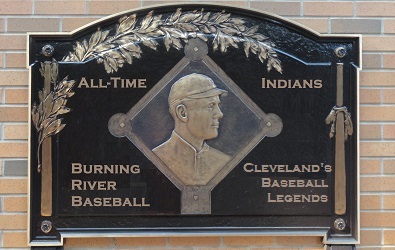Charles Somers was the original owner of the American League franchise, bringing them from a minor league team known as the Lake Shores into the Majors in 1901. For the first few years, he ran things on his own, but in 1903 he would bring in Ernest S. Barnard to help out. Barnard would work his way through the organization for the next 26 years, becoming the single most important person in the Indians front office and eventually, the American League.
Barnard was born in West Virginia in 1874 and, following his graduation from Otterbein College in Westerville, Ohio, became the school’s football and baseball coach. In 1899, he coached football at Ohio Medical University before going to work at the Columbus Dispatch as the sports editor.
It wouldn’t be until the 1903 season that Barnard was hired by Somers, initially becoming the traveling secretary for the Cleveland Blues. With Somers running the team, the Blues (then the Naps) struggled even after acquiring Napoleon Lajoie and despite some incredible seasons from Earl Moore, Addie Joss and Bill Bernhard on the mound. With a franchise record of 536-486, but never a finish better than third in the brand new American League, Barnard was promoted to general manager in 1908.
While the team did win 90 games and finish second in his first season as GM, Barnard can’t be credited too much with this success and it would still be quite awhile before they reached their ultimate goal of winning a pennant and the World Series.
Beyond the stars like Joss, Moore and Lajoie, there wasn’t much to get excited about on the Naps, but Barnard changed that. In 1909, he brought back former Cleveland Spiders star pitcher Cy Young for two great seasons in a trade for Charlie Chech, Jack Ryan and $12k. He also bolstered the rotation by purchasing Vean Gregg in 1909, a move that gave the Naps an ace even after the untimely death of Joss in 1911.
Offensively, the Naps needed help as well beyond the two Hall of Famers Lajoie and Elmer Flick, so Barnard purchased 22 year old outfielder Shoeless Joe Jackson although he was forced to make a second move with Jackson just two years later due to financial reasons. He further added to the legacy of Cleveland baseball by purchasing Ray Chapman in 1911, then Jim Bagby Sr. and Stan Coveleski in 1915.
As mentioned with Jackson, the Naps were going through some financial problems and these lead to the sale of Lajoie prior to the 1915 season and eventually the sale of the team in 1916 from Somers to Jim Dunn. One of Dunn’s first moves was to make the team his own by firing Barnard and bringing in Bob McRoy as the GM, but it took less than a year for Dunn to realize the importance of Barnard and he brought him back before the 1918 season.
By 1918, Coveleski and Bagby were superstars as was one of Barnard’s last acquisitions before being fired, future Hall of Famer Tris Speaker. Barnard would name Speaker manager in 1919 to head a team that had become a juggernaut by his design. From 1917 through 1919, the Indians won 58% of their games and finished second in the AL two years in a row. Under Speaker, with Coveleski and Bagby at their peaks, the Indians would finally win their first World Series in 1920, largely thanks to the construction effort of Barnard.
The Indians would continue to flourish under Barnard for two more years, winning 94 games in 1921 and finishing second in the AL and going .506 and finishing fourth in 1922, before Dunn died and Barnard was promoted to team president. As president, the Indians were significantly less successful. After running the team as president through 1927, Ban Johnson was removed as team president and Barnard helped facilitate the sale of the Indians from Dunn’s estate to Alva Bradley, who would own the team 19 years, through 1946, still the longest run under a single owner in franchise history.
Barnard was selected as the new American League president later in 1927 and served a three year term through 1930, but just when he had been resigned for another three years, he died in December of 1930 at the age of 56.
Barnard gave more than half of his life to the Indians, taking them from a rudderless (and nearly nameless) team in 1903 and bringing them to the promised land of World Series glory. He built a team stacked with stars and future Hall of Famers, the likes that wouldn’t be seen again in Cleveland until the mid-1940’s. There’s nothing more than you can ask from a GM and the Indians were lucky that he was their first.
Add The Sports Daily to your Google News Feed!
